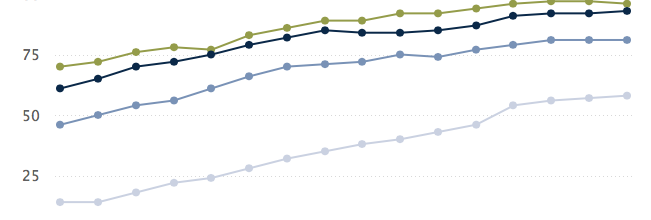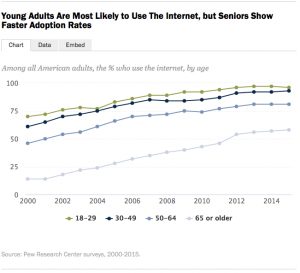Internet Use Nears Saturation
Here’s a rosy picture: the Pew Internet and American Life Project’s data shows that Internet use is effectively universal for some very significant US population groups:
- 96% of young adults (aged 18-29) use the Internet
- 95% of Americans with college degrees use the Internet
- 97% of American homes with household incomes above $75K use the Internet
- 97% of English-speaking Asian Americans use the Internet
- Men and women are equally likely to be Internet users
95% in most measurements of technology adoption is effectively universal use; sampling isn’t really precise enough to reach beyond 97% with any confidence.
Given this generally upbeat and perky set of facts, what’s a pessimist to do? Luckily for the professional merchants of doom, the picture isn’t entirely rosy because there are other population groups who regard Internet use as less than essential. The most hardcore group of Internet skeptics are seniors, whose Internet adoption rate is a measly 58%. That sounds pretty horrible until you look at the trend line.
The 58% adoption rate among seniors stands in sharp contrast to the 14% rate this group showed in 2000, at the dawn of the broadband era. We can thank Facebook and cute grandchildren for that, I believe. But the overall message is that seniors are catching up in a big way.
Another possible source of woe is high school dropouts, traditionally low adopters because of low literacy, low income, and low interest in tech. But even that group is rallying as they’ve nearly closed the gap with high school graduates. You don’t need to be literate to watch videos, make memes, or leave comments in Facebook with “there’s” and “theirs” confused.
The most genuine source of trouble is in rural America. Urban and suburban adoption is up from the mid-50%s in 2000 to 85% today, but rural America has only increased from 42% to 78% over the same period. OK, that’s a faster rate, 86% rural growth vs. 57% suburban/urban growth, but the current figure could be better.
So what’s the problem with Internet use in rural areas? It’s actually pretty simple: the rural population is more heavily older, less educated, and lower income than the urban and suburban populations. The White House has published data that show:
- Urban poverty level is 12% while the low-density rural poverty rate is 16%
- Seniors are also 12% of the urban population, and just below 16% of the extreme rural population
- 58.4% of urban residents have education beyond high school, but just 48.4% of low density rural residents went beyond high school.
So one can easily surmise that rural people have bigger issues than Internet connections.
Universal service isn’t going to make a dent in rural Internet adoption, because we essentially have it already as long as we don’t arbitrarily exclude satellite and terrestrial wireless from the picture; the wireless networks cover over 98% of the US in any case.
Some argue that subsidy programs for wired broadband in rural areas will help get more people online, but I suspect these programs are most effective when they include a big dose of consciousness raising. Seniors who don’t use the Internet say they either regard it as scary or irrelevant; if you’ve lived without it for 70 years, that’s understandable. But low Internet use in rural America isn’t simply problem that can be instantly corrected by faster, wired, subsidized networks in the countryside, as attractive as that may be for many reasons.
It’s not surprising that the usual suspects are beating the drum for more government spending on rural networks: Susan Crawford bemoans the state of broadband in New Hampshire, despite the fact that it’s pretty darn good. The Granite State actually has faster broadband than its neighbors Vermont and Maine, with an average download speed of 35 Mbps according to Netindex by Ookla, the people who bring you Speedtest. Vermont’s average is 23.55, but it’s more rural and a bit technophobic, having recently adopted a GMO labeling law and continuing to fight vaccinations. New Hampshire isn’t as good as Texas, where the average download speed is 43 Mbps, but it’s better than the 31 Mbps OECD average, the 32 Mbps EU average, or the 33 Mbps G8 average. That’s performance rather than adoption, but it shows that those who get broadband in New Hampshire are getting a quality product.
In any event, Internet use by the least engaged population groups, seniors and rural residents, is growing rapidly, so whatever we’ve been doing for the last 15 years has worked.




